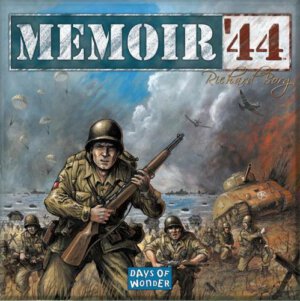
You can now download and play the four Overlord scenarios from those expansions: Hedgerow Hell, Cadets of Saumur, Tigers in the Snow and Operation Market Garden.
You can find these and other downloadable scenarios in the Memoir ’44 Official Scenarios .
Hedgerow Hell:
After a month of heavy fighting, the Germans finally lost Hill 192 the previous night (See “Attack on Hill 192”, scenario WF14 on p. 30 of the Memoir ’44 Air Pack). For the first time since June they no longer dominate the road to Saint-Lô. Should US High Command be able to deploy the 5th Corps into a large-scale armored offensive, the city will finally be within reach.
But the German elite Parachute units have taken advantage of darkness to pull back onto Hill 101 in the vicinity of the Bayeux Highway near la Boulaye, as well as onto Hill 147 on Martinville’s Ridge northeast of Saint-Lô. Reinforced by elements of the Panzer Lehr, they have set up a line of defense in the endless cover of fields, woods and streams.
Their airpower grounded by poor weather and their tanks mired in unforgiving “bocage” country, the Allies must place the burden of the attack on the shoulders of their infantry yet again. What awaits the weary US troops will forever be known as “Hedgerow Hell”…
The stage is set, the battle lines are drawn, and you are in command. The rest is history.
Cadets of Saumur:
Saumur – June 19, 1940. The Battle of France is lost; the Germans are now ready to cross the River Loire.
The meager French troops standing ready and lined up to defend it are the Officer Cadets from the Cavalry School at Saumur, reinforced with a Battalion of the Infantry School at St-Maixent and hodgepodge remnants of the French army.
At the first sight of the enemy, they blow the bridges. Embarking on rafts, the Germans soon attempt to cross the river on the islands at Gennes and East of Saumur. The cadets, dug-in and with no real option for retreat, resist heroically, inflicting heavy losses on the enemy. Their valiant efforts are not enough however, and by June 21, the Germans are already breaking through to the South-West. The following day, June 22, 1940, the French army capitulates: The armistice is signed at Rethondes, and takes effect on June 25.
Tigers in the Snow:
Hot on the heels of their success in Operatsiya Bagration, Soviet forces struck deep towards the Baltic coast, rapidly severing communications between German Army Group North and what little was left of Army Group Center. By early October 1944, the Soviets were in view of the Baltic Sea, near the port of Memel, definitively cutting off Army Group North from any retreat route through East Prussia.
Despite Guderian’s plea for an evacuation by sea and subsequent redeployment in Central Europe where forces were desperately needed to help stabilize an increasingly dicey situation, Hitler stubbornly refused. Instead, he ordered the 200,000+ German troops to entrench themselves, in the hope of using the Courland Pocket as a springboard for a future offensive.
Little did the Führer realize that what he insisted on calling a bridgehead (the Kurland-Brückenkopf) would only become a bridge to oblivion for his haplessly trapped German divisions; They would go on to resist six major battles before finally surrendering to Marshal Govorov on May 8, 1945. The majority of the 200,000+ men of Army Group North would be marched into Soviet prison camps to the East, most of them never to return.
Operation Market Garden:
The largest airborne operation of all time, Operation Market Garden was a bold attempt by Field Marshal Montgomery to drop three entire Airborne Divisions behind the enemy lines, in German-occupied Netherlands. Their tactical objective: To capture and hold all the major water crossings along a narrow 60-mile stretch of highway and into northern Germany. British XXX Corps would then rush onwards from the Dutch-Belgian border and across the Maas and Lower Rhine to outflank the Siegfried Line and choke off the Ruhr, Germany’s industrial heartland.
The daylight drops were initially successful, with the capture of the Waal bridge at Nijmegen, but German resistance was stronger than expected; the British 1st Airborne Division failed to secure the bridge at Arnhem. British ground advance was hampered by marshy ground. Eindhoven was eventually captured by a joint Airborne and Armor assault, but British XXX Corps failed to relieve the 1st Airborne Division. Despite the latter’s valiant hold out at Arnhem bridge, the planned advance had to be abandoned and Monty wouldn’t cross the Rhine until the spring of 1945.
- A Dungeon Delve for Kids?: A Review of Dungeon! - Oct 24, 2022
- Better, Stronger, Faster | Descent: Journeys in the Dark Second Edition Reviewed - Oct 23, 2022
- Your Planet is Doomed!: Invasion from Outer Space Reviewed - Oct 22, 2022

















